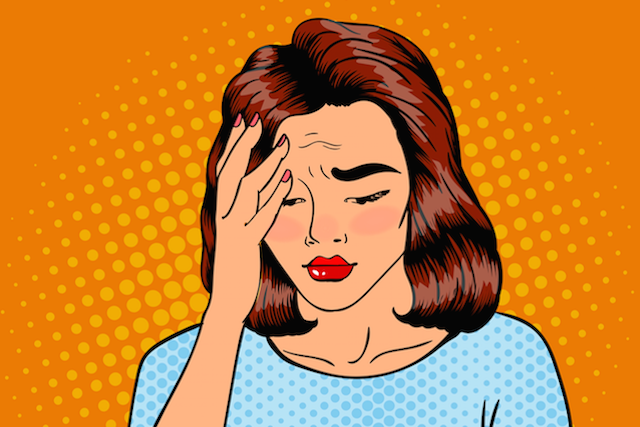
“No problem is insurmountable. With a little courage, teamwork, and determination, a person can do anything.” ~Unknown
Some problems seem far too overwhelming to solve. When you’re buried in debt or trying to bounce back from a huge error in judgment, it can feel like there’s no way out.
I remember when I first learned about my fibroids last year. Since I didn’t have health insurance at the time, I feared I wouldn’t be able to afford treatment, and I was tempted to beat myself up for allowing myself to be uninsured.
On top of that, I worried about my health. I wondered: Why did I develop those growths in the first place? What if they grew uncomfortably large before I was able to remove them? And what if I had other undiagnosed conditions?
Overpowered as I was with fears and regrets, it felt nearly impossible to identify a solution. But there was one—and it was far simpler than I realized at first.
As soon as I focused and stopped getting caught up in “should haves” and “what ifs,” I started researching insurance plans and found one for people with pre-existing conditions.
Of course, that was only the first step. I needed to find a good doctor, pick the best treatment, and find the money to pay for my part of the surgery. But it was all doable.
It may have taken several months, but eventually, I made my way to the other side of that challenge.
Now, three months post-surgery, I’m healthier and more energized. And though I know my fibroids can grow back at any time, regardless of what I do, I’m prepared to handle that if and when it happens.
I know that if the problem comes back, I can overcome it.
When we’re knee-deep in the messiness of an obstacle, it can feel like there’s no way around it. There isn’t—if we aren’t open to discovering it. We can only create and follow a plan if we believe it’s possible.
If your current challenge seems insurmountable, it might help you to step back and try to see things differently.
These questions may help you change your thinking about this problem and discover the action steps to solve it.
Taking Responsibility
When you acknowledge and accept a problem, and take responsibility for it, you then have the power to solve it. Start by asking yourself:
1. Did you play any part in creating this problem?
2. Are you doing anything now that might be making things worse?
3. Does a part of you want to hold onto the problem, maybe because it feels familiar or because there’s some pay off in keeping things as they are?
4. Are you waiting for someone else to step in and fix things for you?
5. Are you blaming someone else in a way that limits the action you can take?
Putting Things in Perspective
Are you overwhelmed because this seems like the worst thing that ever happened to you? Take a time out and ask yourself:
6. On a scale of one to ten—ten being the biggest hardship you’ve ever faced in your life—where does this problem fall?
7. Will this issue be relevant to you in one year? One month? One week?
8. Think about the major areas of your life—work, family, and hobbies, for example. How many areas does this one problem impact?
9. How much of your stress comes from the problem itself, and how much of it has to do with how (and how often) you’re thinking about it?
10. If the worst that could possibly happen happened, could you get through it, and maybe even benefit in some way?
Addressing Your Emotions
Hard to focus because you’re freaking out? Step back, take a deep breath, and ask yourself:
11. If you’re getting caught up in “what if” scenarios, can you remember other times when you imagined all the horrible things that could happen and none of them did?
12. If you’re feeling overwhelmed, can you break the problem into smaller, more manageable parts?
13. If you’re feeling defeated, can you see this is a test of your strength and impress yourself by rising to the occasion?
14. If you’re feeling guilty, can you express your remorse and begin forgiving yourself—and if not, what would it take to do that?
15. Can you make some time for deep breathing, meditation, or yoga to create some mental stillness?
Realizing It’s Not Insurmountable
It might be hard right now to see how you will get past this, but first you have to believe you can. Not sure? Ask yourself:
16. Have you successfully addressed similar problems in the past?
17. Have other people overcome similar challenges, and can you learn anything about what they did?
18. If a friend came to you with this problem, would you reassure that person that he or she could get past this, and how would you envision that happening?
19. Could you do this if you had help? Who can you ask for help?
20. Can you visualize yourself getting through this (realistically, not through magical thinking)? If you can visualize it, you can do it!
Working Toward a Solution
If you’ve taken responsibility for your problem, put things in perspective, tamed your emotional response, and recognized you can get through this, now it’s time to make that happen. Start by asking yourself:
21. If you accepted your fear and acted in spite of it, what would that entail?
22. When you create stillness and listen to your gut instinct, what do you learn?
23. What are your three strongest coping skills (creativity, strength, and resourcefulness, for example), and how can use them in this situation?
24. If other people have given you advice, what part of it resonates with you and why?
25. If you stopped making excuses and started taking action, what’s the first thing you would do?
You’ll notice the first four sets of questions all pertain to internal obstacles. That’s because so much of problem solving has to do with getting our own way.
The solutions aren’t always simple, but they become a lot simpler when we focus, take it step by step, and make a conscious effort to stay calm.
What problem’s been stressing you, and what can you do today to change how you think about it and respond to it?
About Lori Deschene
Lori Deschene is the founder of Tiny Buddha. She started the site after struggling with depression, bulimia, c-PTSD, and toxic shame so she could recycle her former pain into something useful and inspire others to do the same. You can find her books, including Tiny Buddha’s Gratitude Journal and Tiny Buddha’s Worry Journal, here and learn more about her eCourse, Recreate Your Life Story, if you’re ready to transform your life and become the person you want to be.
- Web |
- More Posts












 Though I run this site, it is not mine. It's ours. It's not about me. It's about us. Your stories and your wisdom are just as meaningful as mine.
Though I run this site, it is not mine. It's ours. It's not about me. It's about us. Your stories and your wisdom are just as meaningful as mine. 